
We use Twitter to interact, have conversations, voice our opinions, share content and... build links.
I know. Twitter is probably the last place you thought to look for backlinks since you already know that the links placed here are all nofollow.
But Twitter is undeniably the place to go if you’re looking to build links from a position of power rather than the place of weakness so often experienced in traditional link building.
You're not so much asking or requesting—or worse, begging—when on Twitter, you're networking, building relationships and strengthening your brand.
The best marketers are already using the platform as part of their backlink campaign strategy.
We’ve certainly covered plenty of creative linkbuilding hacks here before, but today, I’ll show you how to use Twitter to earn tons of fresh backlinks.
What's the Deal with Twitter Backlinks?
For any newcomers to SEO, search engines use backlinks to your page when calculating SERP rankings.
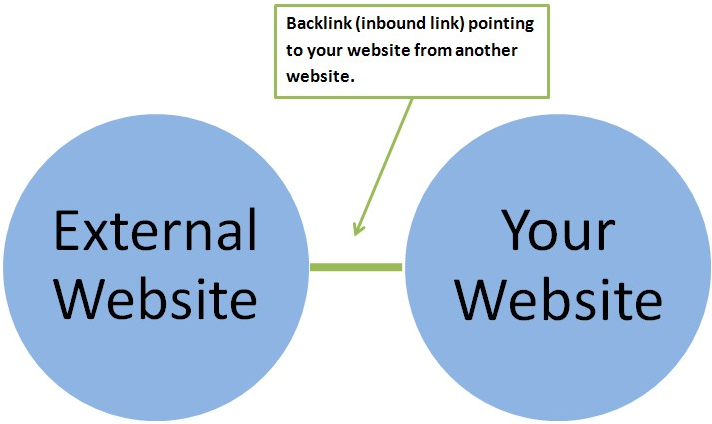
These votes can be broken into two categories: dofollow and nofollow.
This allows website owners to inform search algorithms whether their vote (hyperlink) should count when SERP rankings are calculated.
Whereas dofollow links do influence your SEO and keyword rankings, nofollow links are ignored by the algorithms.
So, what does this mean for backlinks on social platforms? There's no shortage of links pointing to websites on platforms like Facebook, Twitter, Instagram, LinkedIn, Pinterest and many more. Are these links dofollow or nofollow?
Despite heated controversy, the general consensus is that social media backlinks are nofollow.
This means you receive no "link equity" or "link juice" when your page is linked from any social platform whether it be Facebook, Twitter, LinkedIn or somewhere else.
So, is there any point to engage in link building on these channels? Absolutely!
Search ranking isn’t entirely dependent on links.
Studies have shown that positive social signals or the number of likes, retweets and shares also impact rankings.
Search algorithms routinely crawl social media analyzing these signals.
Remember that the job of search engines is to deliver helpful content.
With an expected 3 billion social media users by 2019, ignoring what’s working on social media would be a foolish mistake.
Before you start using social media for SEO, make sure you’re on top of the basics.
Optimize your social profile by including a link in your bio description and the "website" field like done on this Twitter profile.
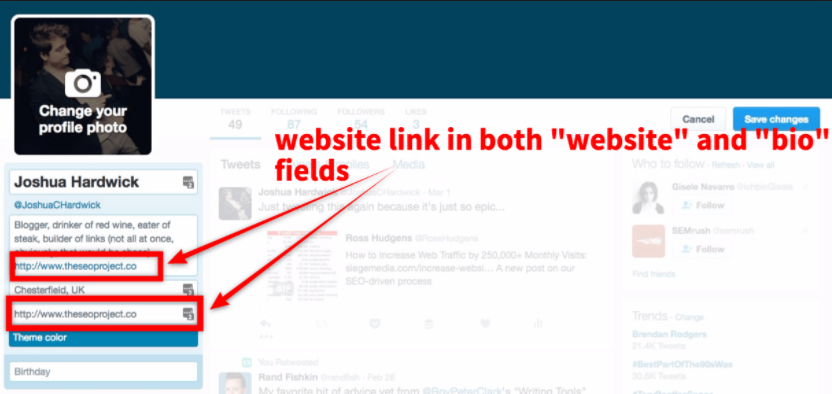
From here, your goal will solely be to get users to share your content on their profile and link to it from their website.
How to Score Backlinks on Twitter for Twice the Nice SEO Benefits
Despite being personable, Twitter is mostly ignored as a link building medium.
For some reason, people still prefer cold emails.
Many remain oblivious to the fact that it’s easier to get someone to share a link on Twitter than their website.
We can thank Twitter’s chat-like communication format for this.
With users looking to spark discussions over interesting content and the fleeting nature of tweets, users are less hesitant to share links on their profile.
And while this doesn’t give you link juice, we do know you'll be rewarded with social signals.
Keeping that in mind, here’s how to get the most out of Twitter:
1. Promote your content
Hashtags aren’t just some trendy pop culture phenomena.
They actually serve a purpose, which is to spread content far and wide at no cost. Think of them as the keywords of social media.
Hashtags are what Twitteratis (Twitter users) use to discover conversations they’re interested in.
Without hashtags, tweets with links to your content won't be found.
So, make sure to include hashtags strategically in your tweet. Limit yourself to two hashtags as more will reduce engagement.
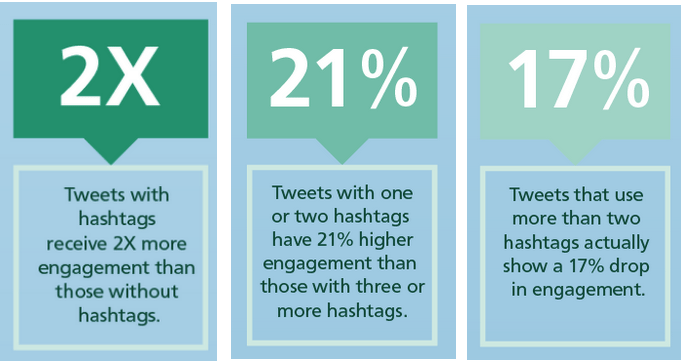
How do you figure out which hashtags to use?
One trick is to look at tweets from influencers in your niche. Chances are they know exactly which hashtags generate the most impressions.
Also, make sure your tweet is optimized for user experience.
This means use images or mini-infographics to increase shareability instead of text.
Alternatively, if you have money to play with, try your hand at paid promotion with ads.
The result of your effort will be heightened activity around your URL and an increase in the number of incoming links to your desired page.
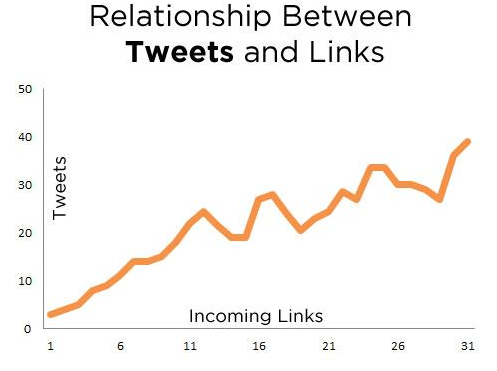
2. Start conversations with influencers
Positive social signals are great but you still want those juicy backlinks.
Domain backlinks are amongst the top 3 ranking factors.
To get links to your website using Twitter, you’ll have to be creative and think outside the box, but it certainly can be done.
Here’s what you need to do:
First, head over to FollowerWonk and use the “search bios” feature to find people that use your target keyword in their bio.
For example, here’s what I see when I look up “content marketing.”
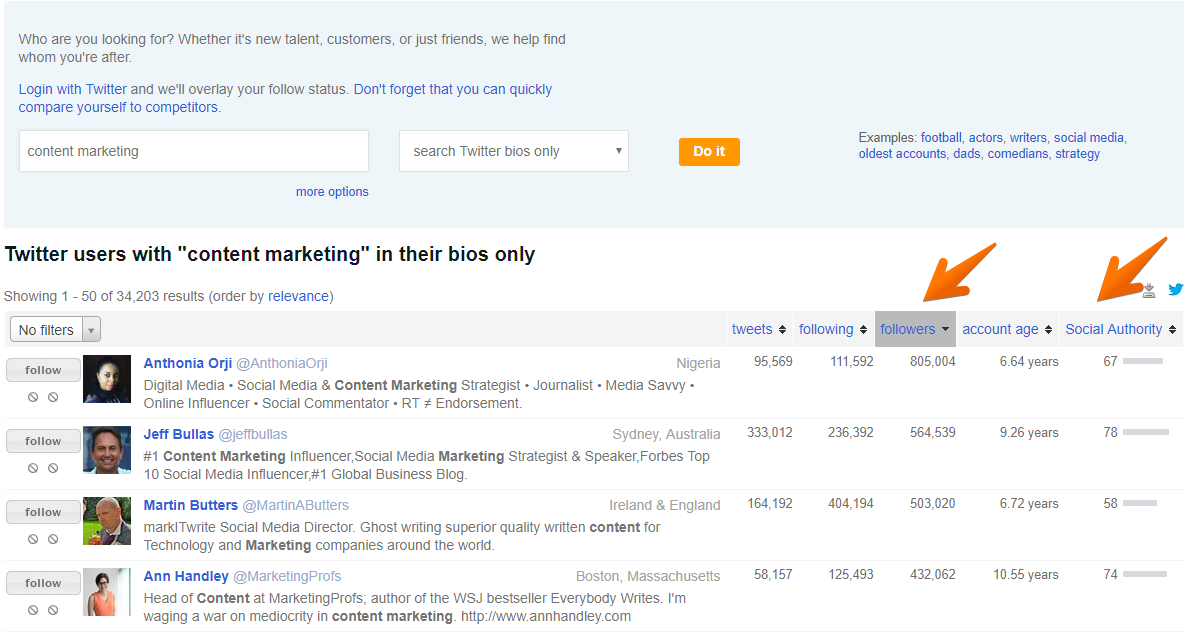
Copy over names that you feel are good targets and sort them by the number of followers.
Use the social authority column to estimate the value of a potential share or link from this person.
3 Twitter Tactics That Deliver Valuable Backlinks
Before you begin outreach, remember this rule:
Never approach or contact someone on Twitter without following them first.
Got it?
Like cold emails, mentions or private messages from an unknown asking for something doesn’t go over so well.
If you’ve put in the work to build a solid relationship, use these outreach strategies for guaranteed link love.
1. Make an offer they can’t refuse
Over time, note down content formats your target likes to share or the topics they are most responsive to.
Use this to inspire your content creation process.
When you’re ready to reach out, send a DM (direct message) asking your target to check out what you’ve created.
The old “I see you mentioned [topic], check out this [topic/link]” works quite well.
If you did your research correctly, they’ll probably share your piece with their followers.
If you really want to hit it out of the park though, contact them asking if they’d like to contribute to a post you’re writing.
Influencers love to be featured as it reinforces their position as an authority on a topic.
In such cases, not only will they share your content with their followers on Twitter but may also include a link for their website users.
2. Be helpful and offer to fix broken links
Broken or dead links on a website are simply bad user experience.
Once spotted, website owners are quick to patch them up. The only problem is that many of them go unnoticed for long periods of time.
This is where you step in.
Being ever so helpful, you’re going fix broken links on your target's website.
3. Purposely leave out links in your content
This tactic is a bit cheeky, so use it sparingly.
It requires you to intentionally leave out backlinks in your content. Many brands use Mention (web listening tool) to monitor for unlinked mentions.
And social media teams routinely contact individuals asking for a fix.
The reverse also works or where you look for people who mention your brand but don’t link to it.
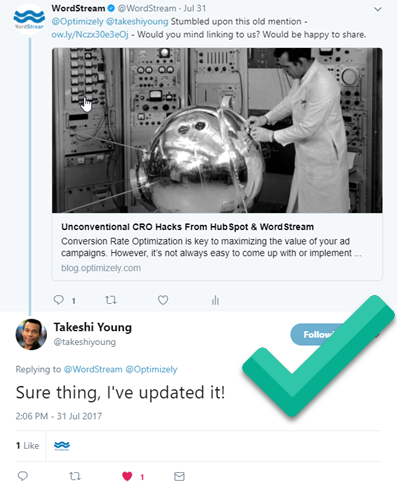
Are You Getting The Most Out Of Twitter?
While it certainly doesn’t rank favorably as a link building tool, don’t underestimate Twitter.
It makes for a great, authentic and organic way to build links.
You’re already using it to share great content and be part of the community. Use that to your advantage.
Instead of spending hours to inundate your target with yet another email, reach out to them on a platform where they’re more receptive.










